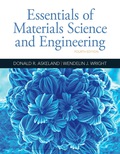
(a)
Interpretation:
The maximum force applied on an aluminum rod needs to be determined.
Concept Introduction:
Expression for stress (S) is given as follows:
Here, Force is F, the cross-sectional area is A.
The expression for Young's Modulus (E) is as follows:
Here, e is the strain.
Length of the rod (L) is expressed as follows:
Strain in the rod is expressed as (e):
Answer to Problem 14.15P
The maximum force applied is 271 N.
Explanation of Solution
Here,
l =10 mm
L= 10 + 0.002
L= 10.002 m
Strain,
e = 0.0002 m
To calculate the area of the rod,
Selecting the value of Young's modulus as 69×109 N/m2 from the table of physical properties of common alloys,
Substitute 69×109 N/m2for E, 0.1963 ×10-4 m2 for A and 0.0002 for e in below equations,
The maximum force applied is 271 N.
(b)
Interpretation:
The maximum force applications on magnesium rod needs to be determined.
Concept Introduction:
Expression for stress (S) is given as follows:
Here, Force is F, the cross-sectional area is A.
The expression for Young's Modulus (E) is as follows:
Here, e is the strain.
Length of the rod (L) is expressed as follows:
Strain in the rod is expressed as (e):
Answer to Problem 14.15P
The maximum force applied is 176 N.
Explanation of Solution
Here,
l =10 mm
L= 10 + 0.002
L= 10.002 m
Strain,
e = 0.0002 m
To calculate the area of the rod,
Selecting the value of Young's modulus as 45×106N/m 2.
Substituting the required values in the below equation,
The maximum force applied in the bar is 176 N.
(c)
Interpretation:
The maximum force applied on beryllium rod needs to be determined.
Concept Introduction:
Expression for stress (S) is given as follows:
Here Force is F, the cross-sectional area is A.
The expression for Young's Modulus (E) is
Where e is the Strain.
Length of the rod (L) is expressed as:
Strain in the rod is expressed as (e):
Answer to Problem 14.15P
The maximum force applied on beryllium is 1138 N.
Explanation of Solution
Here,
l =10 mm
L= 10 + 0.002
L= 10.002 m
Strain,
e = 0.0002 m
To calculate the area of the rod:
From the table of common metals, select the Young's modulus of beryllium as 287×109 N/m2
Substitute the required values in the below equation,
Want to see more full solutions like this?
Chapter 14 Solutions
Essentials Of Materials Science And Engineering
- Design a proportional derivitivecontroller for a plant orsystemthat satisfies the following specifications : 1. is steady-state error is less than 2 % for a ramp input. 2.) Damping ratio (zeta) is greater than 0.7have determined the 3. Once youvalue of kp and kd, then plotthe response of the compensated(with controller) and uncompensated( without the controller, only the plantsystem using MATLAB.arrow_forwardDetermine forces in members BC, GF and CG and nature of forces 9 m D 4 m C 4m 500 F 4 kN 6 kN 4 m 3 m B3 G E Assignment-2 Aarrow_forwardFind forces in all members of the truss shown in Fig. Also find reactions at supports. 12 kN 20 kN ΙΟΧΟΙΟΙ 2 m 2 m 2 m 3 m C G E 4 m B Determine forces in members BC, GF and CG and nature of forces 9 m D 4 m C 4 m F 4 kN 6 kN 4 m 3 m B3 C E Assignment-2arrow_forward
- Only focus on H(3), which the answer is minus 1.26 KJ/mol. This also has the ideal gas of nitrogen gas N2. Two enthalpies need to be calculated for this. The first enthalpy is H = (specific volume) times (pressure difference). For the specific volume of nitrogen, how was 12.089 x10^(-5) m^3/mol obtained? I understand the second enthalpy for the heat capacity for nitrogen gas.arrow_forwardThe term color tone refers to the "temperature" of a photo. Question 17Select one: True Falsearrow_forwardYou cannot add 3-dimensional effects to a shape. Question 18Select one: True Falsearrow_forward
- Which gallery shows available shapes for WordArt text? Question 10Select one: a. Transform b. Shape Styles c. Themes d. WordArt Stylesarrow_forwardWhen you press [Shift][Ctrl] while dragging a corner sizing handle on a graphic, the graphic is ____. Question 9Select one: a. resized while keeping the center position fixed and maintaining its proportions b. resized proportionally c. re-positioned diagonally d. resized diagonally while changing proportionallyarrow_forwardWhat is the term used to describe trimming away part of a graphic to expose only some of it? Question 8Select one: a. Resizing b. Hiding c. Cropping d. Scalingarrow_forward
- To insert a SmartArt graphic in a document, click the SmartArt button in the _____ group on the Insert tab. Question 6Select one: a. Text b. Shapes c. Illustrations d. Pagesarrow_forwardExample 2 The particle has a mass of 0.5 kg and is confined to move along the smooth horizontal slot due to the rotation of the arm OA. Determine the force of the rod on the particle and the normal force of the slot on the particle when 0 = 30°. The rod is rotating with a constant angular velocity 2 rad/s. Assume the particle contacts only one side of the slot at any instant. B =2 rad/s 0.5 m 0.5(9.81)N r F 30° Narrow_forwardBriefly define and discuss the following classes of problems: P, NP, NP-Complete, co-NP, NC, P-Complete.arrow_forward
 MATLAB: An Introduction with ApplicationsEngineeringISBN:9781119256830Author:Amos GilatPublisher:John Wiley & Sons Inc
MATLAB: An Introduction with ApplicationsEngineeringISBN:9781119256830Author:Amos GilatPublisher:John Wiley & Sons Inc Essentials Of Materials Science And EngineeringEngineeringISBN:9781337385497Author:WRIGHT, Wendelin J.Publisher:Cengage,
Essentials Of Materials Science And EngineeringEngineeringISBN:9781337385497Author:WRIGHT, Wendelin J.Publisher:Cengage, Industrial Motor ControlEngineeringISBN:9781133691808Author:Stephen HermanPublisher:Cengage Learning
Industrial Motor ControlEngineeringISBN:9781133691808Author:Stephen HermanPublisher:Cengage Learning Basics Of Engineering EconomyEngineeringISBN:9780073376356Author:Leland Blank, Anthony TarquinPublisher:MCGRAW-HILL HIGHER EDUCATION
Basics Of Engineering EconomyEngineeringISBN:9780073376356Author:Leland Blank, Anthony TarquinPublisher:MCGRAW-HILL HIGHER EDUCATION Structural Steel Design (6th Edition)EngineeringISBN:9780134589657Author:Jack C. McCormac, Stephen F. CsernakPublisher:PEARSON
Structural Steel Design (6th Edition)EngineeringISBN:9780134589657Author:Jack C. McCormac, Stephen F. CsernakPublisher:PEARSON Fundamentals of Materials Science and Engineering...EngineeringISBN:9781119175483Author:William D. Callister Jr., David G. RethwischPublisher:WILEY
Fundamentals of Materials Science and Engineering...EngineeringISBN:9781119175483Author:William D. Callister Jr., David G. RethwischPublisher:WILEY





